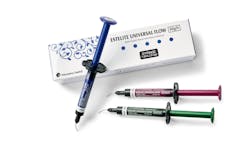Pearls for Your Practice: Estelite Universal Flow by Tokuyama Dental
I’m no professional, but early on in my practice of golf, I realized the way to lower scores was the short game. I practice the short game a lot. I used to meet with a pro twice a month to work on my game, and at least 75% of our time was working on wedges and putting.
When I started those lessons, I had one wedge in my bag—a sand wedge. My golf pro quickly laughed in my face to tell me one wedge wasn’t enough. I still remember him saying, “There are eight different kinds of shots around a green. You can’t have just one club for those.” He was right. Not long after, I added a pitching wedge and a lob wedge. He wanted me to add a gap wedge as well, but I really like my driving hybrid, and I didn’t want to have to take it out of my bag.
I think flowable composite is the “wedge” of our restorative bag. We are often content thinking one flowable is enough. I thought that was the case, but after examining the wide variety of things I use flowable for, I realized one is not enough. That’s where Estelite Universal Flow by Tokuyama Dental comes into play.
Estelite Universal Flow is a supra-nano filled flowable composite that comes in three separate, distinct viscosities. Having different viscosities of flowable is like having different wedges in your golf bag . . . it gives you a wide variety of flexibility in how and where you can use them. I’ve reviewed several other products in the Estelite family. Estelite Omega is Tokuyama’s high-end anterior esthetic composite. Estelite Sigma Quick is a beautiful simplified composite for either anterior or posterior applications. Estelite Universal Flow fits right in with its Estelite family, providing great durability and excellent, simple esthetics.
The three viscosities are super low flow, medium flow, and high flow. Super low flow allows for precision stacking. It is nonslumping and not runny at all. It is great for situations like filling in three-body wear lesions on the cusps of posterior teeth. It also works great for class V lesions. It has 70% filler by weight, so I feel comfortable using it on occlusal surfaces in patients with normal occlusal forces. I also use it often for mockups because of its precision placement.
The medium flow isn’t great for precision stacking, but it doesn’t slump much and does not run much. It has 71% filler by weight, so it also does well on occlusal surfaces where indicated. I use it for small occlusal pit and fissure lesions and preventive resin restorations.
The last option is high flow. It flows very well and is runny by design. It works best as a liner or base in occlusal and class II restorations. It has 69% filler by weight, the least of the three.
It wasn’t until I tried a flowable composite with three different viscosities that I thought I needed three different viscosities, but I use all three of these different products routinely. They come in one universal shade that blends great in the posterior. For definitive restorations in the anterior (not mockups), I would use one of these products in conjunction with either Estelite Omega or Estelite Sigma Quick for the best shade match. Each of these materials is worth a spot in your restorative golf bag, so to speak. Double down the third base line for Tokuyama Dental!
Joshua Austin, DDS, FAGD, FACD, writes the Pearls for Your Practice column in Dental Economics. After graduating from the University of Texas Health Science Center Dental School, Dr. Austin associated for several years. In October of 2009, he opened a solo general practice in a suburban area of San Antonio, Texas. Dr. Austin is involved in all levels of organized dentistry and can be reached at [email protected].
About the Author
Joshua Austin, DDS, MAGD
Joshua Austin, DDS, MAGD, is a graduate and former faculty member of the University of Texas Health Science Center at San Antonio School of Dentistry. Author of Dental Economics’ Pearls for Your Practice column, Dr. Austin lectures nationally on products, dental technology, online reputation management, and social media. He maintains a full-time restorative dentistry private practice in San Antonio, Texas. You may contact Dr. Austin at [email protected].
Updated June 21, 2023

